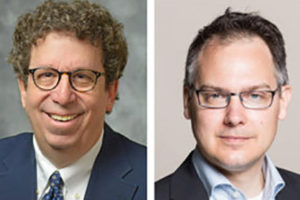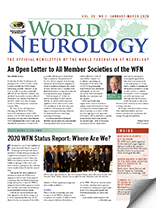By Steven L. Lewis, MD, Editor, and Walter Struhal, MD, Co-Editor
We would like to welcome all neurologists from around the globe to this issue of World Neurology. First, we would like to wish you, your families, and your patients all the very best of health and safety in this time of the global pandemic.

Steven L. Lewis, MD, Walter Struhal, MD
This issue begins with the important message from the president of the World Federation of Neurology (WFN), Dr. William Carroll, to all our member societies and neurologists worldwide, with regard to the COVID-19 crisis. In Dr. Carroll’s adjoining President’s Column, he also reviews the current status of the many activities and plans for the WFN, and in another adjoining column, reports on the recent successes with regard to the WFN’s activities with the World Health Organization (WHO).
It has been a while since a book review has been featured in World Neurology, and we are so pleased that this section has returned with the thoughtful and colorful review by Dr. Mark Hallett (a previous editor of World Neurology) on the book recently published on the history of the National Hospital and the Institute of Neurology at Queen Square written by Drs. Simon Shorvon and Alastair Compston. In addition, Dr. John England, editor-in-chief of the Journal of Neurological Sciences (JNS), provides his Editor’s Update of an important special issue of JNS devoted to opiate addiction.
Dr. Serefnur Ozturk reports on a recent “In the Region” session at the Turkish Neurological Society Annual Neurology Congress that was focused on Women in Neurology. Dr. R.S. Jain provides his report of the many activities surrounding World Stroke Day that were held in Jaipur, India. Drs. Marina Alpaidze and Gia Tomadze describe the recent activities of the WFNs Special Interest Group on Neurosonology held in Tbilisi Georgia. Drs. Nils Erik Gilhus, Aud Kvalbein, and Anette Storstein report on the structure and many important activities and accomplishments of the Norwegian Brain Council.
This issue also features several reports from trainees who participated in department visits with WFN partner societies and hospitals in Austria, Canada, and Germany, with wonderful descriptions of their experiences and great appreciation to their hosts. In this issue’s History section, curated by Dr. Peter Koehler, Dr. Egle Sakalauskaite-Juodeikiene describes the history and debunking of a fascinating “disease” that had neurologic and multisystem manifestations, and the sociocultural factors and biases that underlied the belief in the existence of this condition at the time.
Finally, this issue announces calls for nominations for the next open position for Elected Trustee of the WFN and the mechanisms for nomination for this important position.
In closing, we would like to reiterate our wishes to all for safety and health for you, your families, colleagues, and patients in this remarkable and trying time. For global neurology-related COVID-19 resources and information, please refer to the new page on our website: wfneurology.org/covid-19-and-world-neurology. Please also be on the lookout for additional links and resources on the WFN website to freely and widely available eLearning materials that will be of increasing importance and relevance in this time of social distancing.
